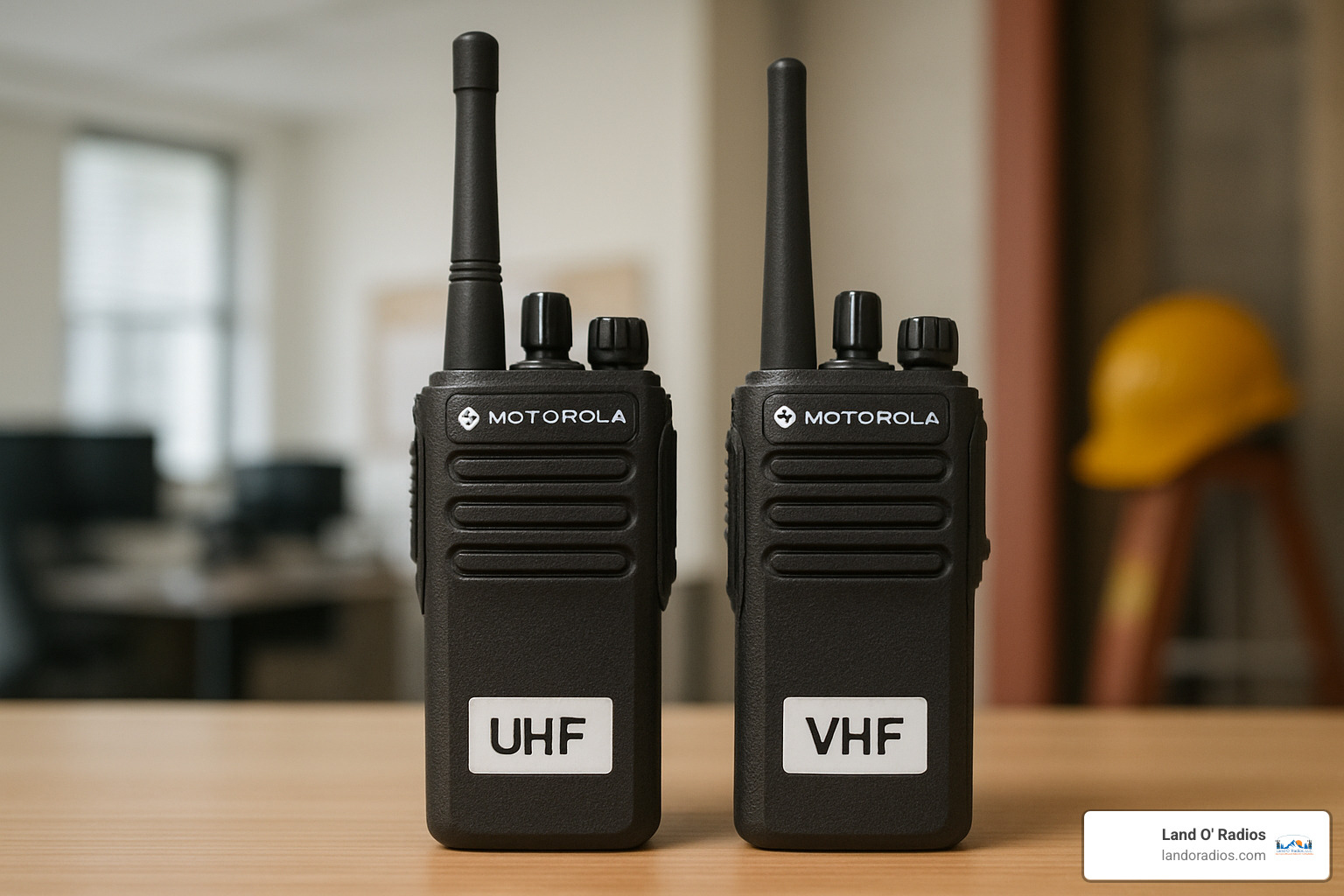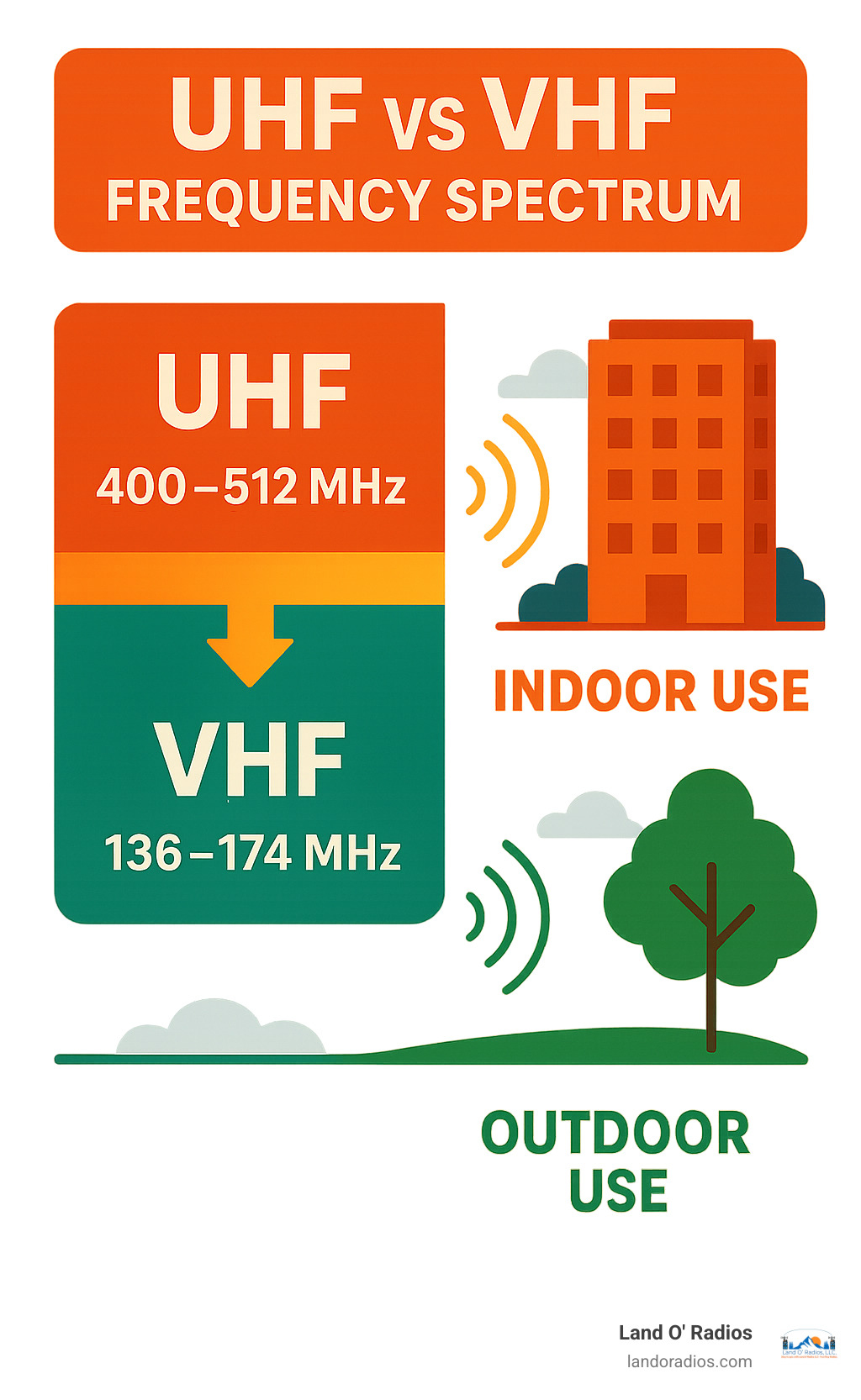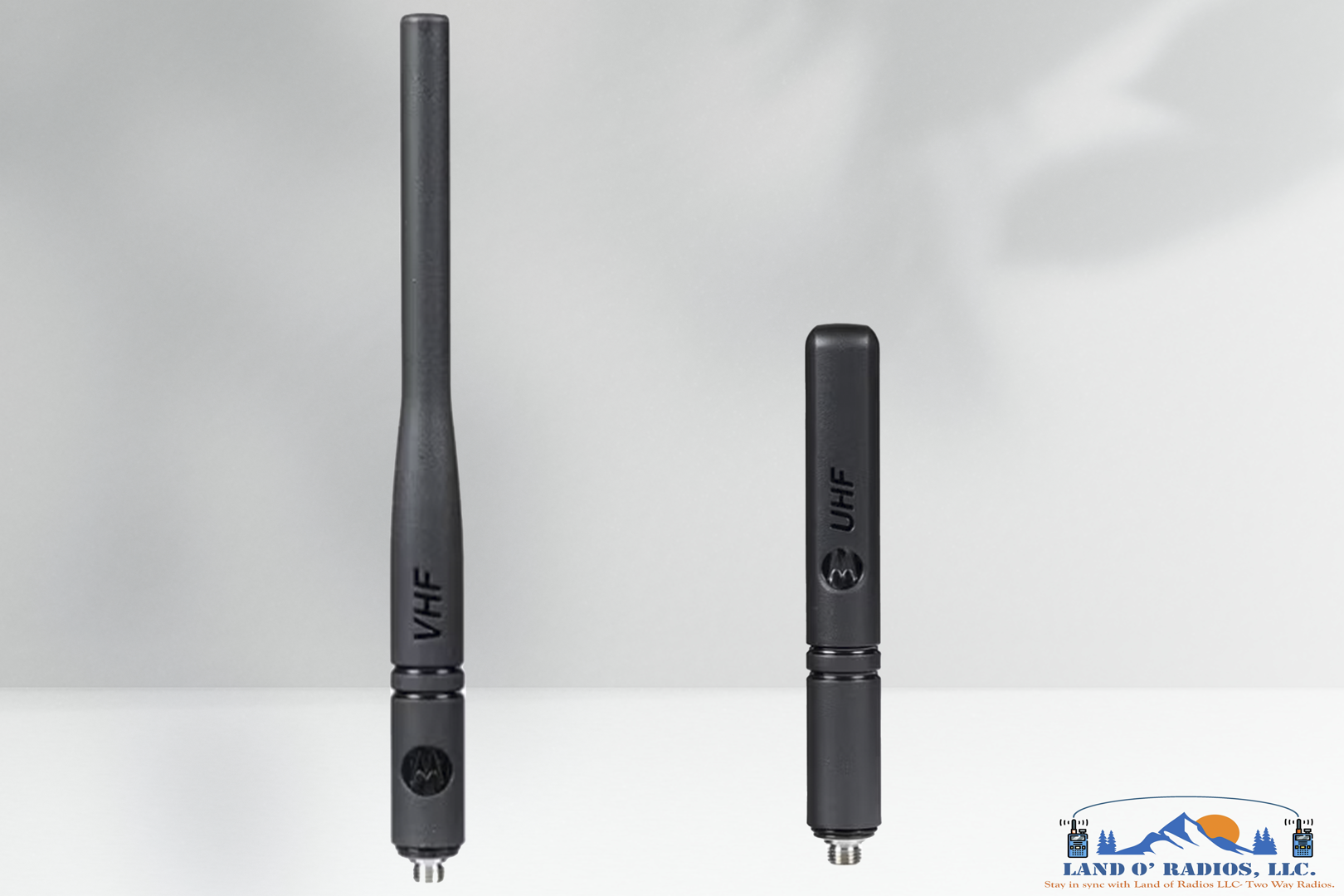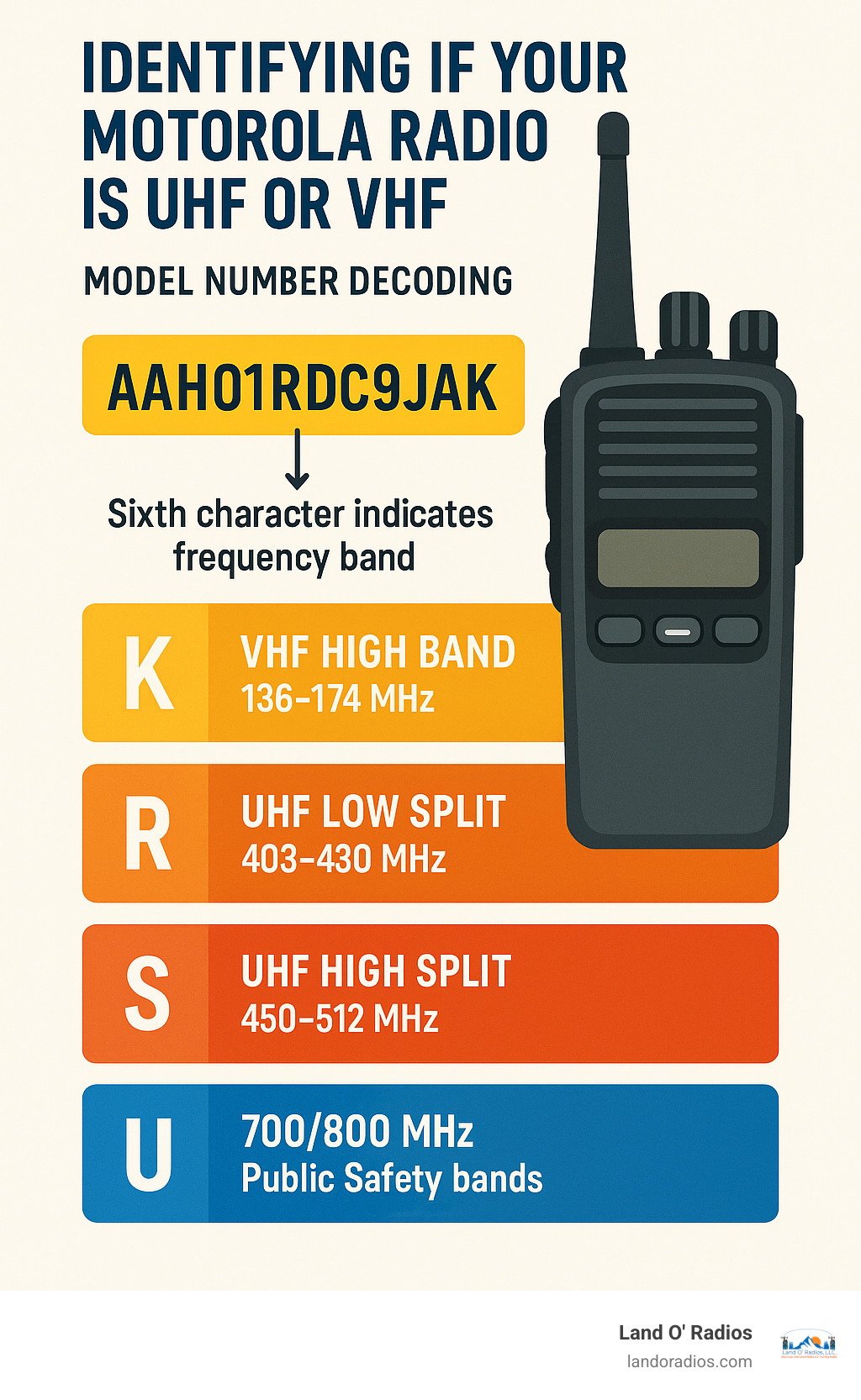Why Understanding Radio Frequency Bands Matters for Your Team

The difference between Motorola UHF and VHF radios comes down to frequency ranges and how those frequencies behave in different environments. Here's what you need to know:
Key Differences:
- UHF (Ultra High Frequency): 400-512 MHz, better for indoor use and penetrating obstacles
- VHF (Very High Frequency): 136-174 MHz, better for outdoor use and longer range in open areas
- Antenna Size: UHF antennas are shorter, VHF antennas are longer
- Battery Life: VHF typically lasts longer due to lower power consumption
- Penetration: UHF cuts through concrete and steel better than VHF
When choosing between these frequency bands, your work environment matters most. As one radio expert puts it: "It's like asking how wet water is" when people ask about range - the answer depends entirely on where you're using the radio.
VHF radios excel outdoors with clear line-of-sight communication across farms, construction sites, and marine environments. UHF radios shine indoors where signals need to penetrate walls, floors, and equipment in warehouses, hospitals, and multi-story buildings.
I'm Rene Fornaris, and with over ten years of experience in two-way radio communications, I've helped countless teams understand the difference between Motorola UHF and VHF radios to make the right choice for their specific needs. Let me walk you through everything you need to know to pick the perfect frequency band for your operation.

Understanding the Difference Between Motorola UHF and VHF Radios
The difference between Motorola UHF and VHF radios starts with their frequency ranges, but extends far beyond simple numbers. These frequency bands behave completely differently in real-world conditions, affecting everything from signal penetration to battery life.
| Feature | VHF (Very High Frequency) | UHF (Ultra High Frequency) |
|---|---|---|
| Frequency Range | 136-174 MHz | 400-512 MHz |
| Wavelength | Longer (5-7 feet) | Shorter (1-2 feet) |
| Best Environment | Outdoor, open areas | Indoor, urban environments |
| Signal Penetration | Poor through obstacles | Excellent through walls/steel |
| Outdoor Range | Superior line-of-sight | Shorter but more consistent |
| Channel Capacity | Fewer available channels | More channels available |
| Power Consumption | Lower battery drain | Higher battery consumption |
| Antenna Length | Longer (6-8 inches) | Shorter (2-4 inches) |
| FCC Licensing | Required for commercial use | Required for commercial use |
Think of it this way: VHF waves are like a pole vault pole trying to get through a forest, while UHF waves are like a pencil - they slip through obstacles much easier. This fundamental difference in wavelength determines how each band performs in your specific environment.
How Frequency Affects Coverage and Clarity
Radio waves don't just travel in straight lines - they bend, bounce, and get absorbed by different materials. Understanding these behaviors helps explain why UHF and VHF perform so differently.
Line-of-sight communication works best with VHF because longer wavelengths can bend slightly with the earth's curvature. This is why VHF is the standard for marine and aviation communications - it can reach farther over open water and flat terrain.
Diffraction occurs when radio waves bend around obstacles. VHF waves, being longer, actually bend better around large obstacles like hills and buildings. However, they struggle to penetrate through these same obstacles.
Multipath interference happens when signals bounce off multiple surfaces before reaching the receiver. UHF signals, with their shorter wavelengths, are less susceptible to this problem indoors, resulting in clearer audio in complex environments.
Digital radios on both bands offer significant advantages over analog systems. Digital processing improves clarity and extends coverage by up to 20% compared to analog radios operating on the same frequency. The FCC provides detailed scientific research on radio propagation that explains these phenomena in greater technical detail.
The Core Difference Between Motorola UHF and VHF Explained
The difference between Motorola UHF and VHF fundamentally comes down to wave behavior. VHF operates in the 136-174 MHz band with wavelengths measured in feet, while UHF operates in the 400-512 MHz band with wavelengths measured in inches.
These MHz bands determine how waves interact with your environment:
- VHF waves are like ocean swells - they travel far over open areas but crash into obstacles
- UHF waves are like ripples - they don't travel as far but can slip through tight spaces
This wave behavior explains why a VHF radio might work perfectly on a farm but fail miserably in a multi-story hospital, while a UHF radio excels in that same hospital but falls short in open fields.
Performance in the Real World: Range, Penetration & Battery Life
Real-world performance depends on three critical factors: how far signals travel outdoors, how well they penetrate obstacles indoors, and how long your battery lasts during operation.
Obstacle penetration varies dramatically between bands. UHF signals penetrate concrete walls, steel structures, and dense foliage much more effectively than VHF. In our testing, UHF radios maintain communication through 3-4 concrete walls where VHF signals are completely blocked.
Urban canyons created by tall buildings reflect and absorb VHF signals, creating dead zones. UHF signals steer these environments more reliably, which is why most city emergency services use UHF frequencies.
Battery runtime differs significantly between bands. VHF radios typically consume 15-20% less power than comparable UHF models. For example, the Motorola CP100D VHF radio delivers up to 8.5 hours of operation under typical use conditions.
Antenna length affects both performance and practicality. VHF antennas need to be longer to match the wavelength, making them more cumbersome but potentially more efficient for outdoor use.

Range Outdoors—When VHF Wins
VHF radios dominate in outdoor environments where line-of-sight communication is possible. Agriculture operations, marine vessels, aviation, and open construction sites all benefit from VHF's superior outdoor range.
Farms and ranches use VHF because signals can travel for miles across open fields. The longer wavelengths follow the earth's curvature better, extending communication range beyond what UHF can achieve in the same conditions.
Marine applications exclusively use VHF for good reason. Coast Guard emergency channel 16 operates on VHF, and these signals carry farther over water than UHF. The lack of obstacles over water plays to VHF's strengths.
Aviation communications rely on VHF for air traffic control and pilot communications. The clear line-of-sight between aircraft and control towers makes VHF the logical choice for this critical application.
Open terrain like highways, large parking lots, and outdoor events favor VHF radios. Security teams at outdoor festivals or construction crews on highway projects often choose VHF for maximum coverage area.
Penetration Indoors—Why UHF Shines
Indoor environments present the opposite challenge - signals must penetrate walls, floors, and equipment rather than travel long distances. This is where UHF's shorter wavelengths provide a decisive advantage.
Warehouses with metal racking, concrete floors, and high ceilings challenge any radio system. UHF signals steer these obstacles more effectively, maintaining communication between dock workers, forklift operators, and supervisors throughout the facility.
Hospitals present unique challenges with concrete construction, metal equipment, and multiple floors. UHF radios allow doctors, nurses, and support staff to communicate reliably from emergency rooms to patient floors to basement facilities.
Schools use UHF radios for security teams, maintenance staff, and administrators. The ability to communicate through classroom walls, between floors, and across campus buildings makes UHF the preferred choice for educational environments.
Metal-rich environments like manufacturing facilities, casinos with reinforced concrete, and retail stores with extensive metal fixtures all favor UHF frequencies for reliable indoor communication.
Battery Considerations on Each Band
Battery life varies between UHF and VHF due to power consumption differences. VHF radios generally offer longer battery life because they operate at lower frequencies, requiring less power to generate the same signal strength.
mAh ratings on batteries remain the same, but runtime differs. A 2000 mAh battery might power a VHF radio for 12-14 hours but only run a comparable UHF radio for 10-12 hours under similar conditions.
Duty cycle affects battery life on both bands. Heavy users who transmit frequently will see greater battery drain on UHF radios compared to VHF models with similar usage patterns.
Power settings can extend battery life on both bands. Many Motorola radios offer low, medium, and high power settings. Using low power for nearby communication can significantly extend battery runtime.
Smart chargers help maximize battery life regardless of frequency band. Modern charging systems prevent overcharging and condition batteries for optimal performance across both UHF and VHF radios.
Choosing the Right Band for Your Industry & Environment
Selecting between UHF and VHF requires evaluating your specific environment, communication needs, and operational requirements. We've developed a systematic approach to help you make the right choice.
Environment audit should be your first step. Walk through your facility or work area and identify:
- Number of walls between communication points
- Construction materials (concrete, steel, wood)
- Indoor versus outdoor usage ratio
- Presence of metal equipment or fixtures
- Required communication distances
Licensing needs apply to both bands for commercial use. The FCC requires proper licensing for business radio operations, regardless of whether you choose UHF or VHF frequencies.
Interference considerations vary by location and frequency band. UHF offers more available channels, reducing the likelihood of interference from other users. VHF has fewer channels but may experience less congestion in rural areas.
Scalability planning affects long-term costs and performance. Consider future expansion needs and whether your chosen frequency band can accommodate additional users without performance degradation.
For comprehensive guidance on radio implementation, check out our Two-Way Radio Training best practices for new users.

Quick-Select Guide by Sector
Different industries have established preferences based on their unique communication requirements and operating environments.
Hospitality operations typically choose UHF radios like the Motorola CP Series for front-of-house and back-of-house coordination. The compact antennas and excellent building penetration make UHF ideal for hotels, restaurants, and event venues.
Agriculture and farming operations favor VHF radios for communication across open fields, between buildings, and with mobile equipment. The superior outdoor range of VHF makes it the logical choice for rural operations.
Event security teams rely on UHF radios for crowd control, venue coordination, and emergency response. The ability to communicate through structures and around obstacles makes UHF essential for security operations.
Trucking and transportation companies often use VHF for long-haul communications and highway operations. The extended range over open terrain suits the mobile nature of transportation operations.
Education facilities including schools, colleges, and universities typically deploy UHF systems for security, maintenance, and administrative communications. The multi-building, multi-floor nature of educational campuses favors UHF penetration capabilities.
Improving Signal Strength on Any Band
Regardless of which frequency band you choose, several strategies can improve signal strength and communication reliability.
Repeaters extend range and improve coverage for both UHF and VHF systems. These devices receive weak signals and retransmit them at full power, effectively doubling your communication range.
External antennas can significantly improve performance. Upgrading from a standard antenna to a high-gain model can increase range by 20-30% on either frequency band.
Proper mounting affects antenna performance more than most users realize. Antennas work best when mounted vertically and away from metal objects that can interfere with signal propagation.
Firmware updates from Motorola can improve performance and add features to existing radios. Regular updates ensure your equipment operates at peak efficiency regardless of frequency band.
Compatibility, Model IDs & Future-Proofing Your Fleet
Understanding Motorola's model numbering system and compatibility requirements helps ensure your radio investment delivers long-term value and seamless operation.
Model-number decoding follows specific patterns that indicate frequency band, power output, and feature sets. Learning these patterns helps you identify compatible radios and avoid costly mistakes.
Dual-band digital radios offer flexibility by supporting both UHF and VHF frequencies in a single device. These advanced radios cost more but provide maximum versatility for complex operations.
DMR (Digital Mobile Radio) technology represents the future of two-way radio communications. DMR systems offer improved audio quality, extended battery life, and advanced features like text messaging and GPS tracking.
Cross-band gateways enable communication between UHF and VHF radios through specialized equipment. While expensive, these solutions allow mixed fleets to communicate across frequency bands.
For detailed technical information about antenna design and radio wave propagation, consult scientific research on antenna design from authoritative sources.
Identifying If Your Motorola Radio Is UHF or VHF
Determining your radio's frequency band prevents compatibility issues and ensures proper operation. Several methods can help you identify whether your Motorola radio operates on UHF or VHF frequencies.
Label check provides the most reliable identification method. Look for frequency information printed on the radio's label, typically located on the back or bottom of the device.
Sixth character rule applies to many Motorola model numbers. If the sixth character is 'K', the radio operates on VHF frequencies. Other letters indicate different frequency bands as outlined above.
CP200d example: A Motorola CP200d with model number AAH01QDC2AA1AN operates on UHF frequencies, while a model ending in KDC2AA1AN would be VHF.

Can Motorola UHF and VHF Radios Talk to Each Other?
This question about the difference between Motorola UHF and VHF compatibility comes up frequently, and the answer is more complex than a simple yes or no.
Same frequency requirement means radios must operate on identical frequencies to communicate directly. A UHF radio on 462.550 MHz cannot talk to a VHF radio on 151.820 MHz without additional equipment.
Interoperability bridges can connect UHF and VHF systems through specialized gateway equipment. These devices receive signals on one band and retransmit them on another, enabling cross-band communication.
Digital dual-band options include radios that can switch between UHF and VHF modes. These advanced devices cost significantly more than single-band radios but provide maximum flexibility for complex operations.
Most standard business radios operate on either UHF or VHF, not both. Planning your radio system around a single frequency band ensures reliable communication and simplifies operation.
Tips for Adding New Radios to an Existing Fleet
Expanding your radio system requires careful planning to maintain compatibility and performance across all devices.
Frequency alignment ensures new radios operate on the same channels as existing equipment. Document your current channel plan before purchasing additional radios.
Analog vs digital compatibility matters more than frequency band in some cases. Mixing analog and digital radios on the same system can cause communication problems even when frequencies match.
Channel naming and programming should remain consistent across all radios in your fleet. Standardized channel names and functions reduce confusion and improve operational efficiency.
Training requirements may differ for new radio models, even within the same frequency band. Plan for user training when introducing new equipment to your existing fleet.
Firmware synchronization ensures all radios operate with compatible software versions. Mismatched firmware can cause communication problems even between identical radio models.
For comprehensive guidance on selecting the right radio for your needs, explore our Best Commercial Radios guide for 2025.
Frequently Asked Questions about the Difference Between Motorola UHF and VHF
What frequency ranges do Motorola UHF and VHF radios use?
Motorola VHF radios operate in the 136-174 MHz range, while UHF radios use 400-512 MHz frequencies. These ranges are further divided into specific bands:
- VHF high band: 136-174 MHz (most common for business use)
- UHF low split: 403-430 MHz
- UHF high split: 450-512 MHz
The FCC regulates these frequency allocations and requires proper licensing for commercial use on both bands.
How far can each band reach in typical conditions?
Range depends heavily on environment and obstacles. In open outdoor conditions, VHF radios typically achieve 2-5 miles of reliable communication, while UHF radios reach 1-3 miles. However, these numbers change dramatically with terrain, buildings, and weather conditions.
Indoor range favors UHF radios, which might communicate through 3-4 floors of a building where VHF signals are blocked after 1-2 floors. The key is matching the frequency band to your specific environment rather than focusing solely on maximum range specifications.
Will a UHF antenna work on a VHF radio and vice versa?
No, antennas are specifically tuned for their intended frequency bands. Using a UHF antenna on a VHF radio (or vice versa) will significantly reduce performance and may damage the radio's transmitter.
VHF antennas are longer (typically 6-8 inches) to match the longer wavelengths, while UHF antennas are shorter (2-4 inches) for optimal performance on higher frequencies. Always use the correct antenna for your radio's frequency band to ensure optimal performance and equipment longevity.
Conclusion
The difference between Motorola UHF and VHF radios ultimately comes down to matching the right frequency band to your specific environment and communication needs. VHF excels in outdoor, open environments where line-of-sight communication is possible, while UHF dominates indoor and urban settings where signals must penetrate obstacles.
Environment matching should drive your decision. If your team primarily works outdoors with clear sight lines, VHF offers superior range and battery life. If you operate indoors or in urban environments with buildings, walls, and equipment, UHF provides the penetration power you need.
Battery planning differs between bands, with VHF typically offering 15-20% longer runtime than comparable UHF radios. Factor this into your operational planning, especially for extended shifts or remote operations.
Model identification using Motorola's numbering system helps ensure compatibility and prevents costly mistakes. Remember the sixth character rule and suffix letter meanings when selecting additional radios for your fleet.
At Land O' Radios, we understand that choosing the right radio frequency band is crucial for your team's success. Our curated selection of best-selling and customer-loved Motorola models ensures you get reliable communication equipment that matches your specific needs.
Whether you choose UHF for indoor penetration or VHF for outdoor range, the key is selecting equipment that works reliably in your environment. For more information about choosing your next radio system, visit us at Land O' Radios where our expertise helps you make the right choice for your communication needs.








